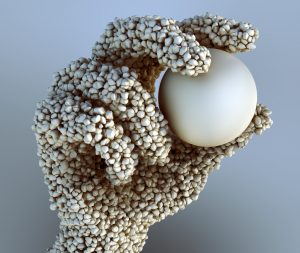e-Roma

I am text block. Click edit button to change this text. Lorem ipsum dolor sit amet, consectetur adipiscing elit. Ut elit tellus, luctus nec ullamcorper mattis, pulvinar dapibus leo.
Partners




Publications
2024
Journal articles
-
- titre
- Neural Inpainting of Folded Fabrics with Interactive Editing
- auteur
- Guillaume Gisbert, Raphaëlle Chaine, David Coeurjolly
- resume
- We propose a deep learning approach for inpainting holes in digital models of fabric surfaces. Leveraging the developable nature of fabric surfaces, we flatten the area surrounding the holes with minor distortion and regularly sample it to obtain a discrete 2D map of the 3D embedding, with an indicator mask outlining holes locations. This enables the use of a standard 2D convolutional neural network to inpaint holes given the 3D positioning of the surface. The provided neural architecture includes an attention mechanism to capture long-range relationships on the surface. Finally, we provide ScarfFolds, a database of folded fabrics patches with varying complexity, which is used to train our convolutional network in a supervised manner. We successfully tested our approach on various examples and illustrated that previous 3D deep learning approaches suffer from several issues when applied to fabrics. Also, our method allows the users to interact with the construction of the inpainted surface. The editing is interactive and supports many tools like vertex grabbing, drape twisting or pinching.
- Accès au texte intégral et bibtex
-


2023
Software
- titre
- Inpainting Holes in Folded Fabric Meshes
- auteur
- Guillaume Gisbert, Raphaëlle Chaine, David Coeurjolly
- resume
- Inpainting Holes in Folded Fabric Meshes This repository contains a research prototype implementation of the paper Inpainting Holes in Folded Fabric Meshes, Computers & Graphics. The method proposes to fill holes in triangle mesh surfaces representing fabrics. The software allows the user to provide a mesh with a hole and to fill it.
- Accès au bibtex
-

2020
Journal articles
-
- titre
- FAKIR : An algorithm for revealing the anatomy and pose of statues from raw point sets
- auteur
- Tong Fu, Raphaëlle Chaine, Julie Digne
- Accès au texte intégral et bibtex
-


-
- titre
- Code Replicability in Computer Graphics
- auteur
- Nicolas Bonneel, David Coeurjolly, Julie Digne, Nicolas Mellado
- resume
- Being able to duplicate published research results is an important process of conducting research whether to build upon these findings or to compare with them. This process is called "replicability" when using the original authors' artifacts (e.g., code), or "reproducibility" otherwise (e.g., re-implementing algorithms). Reproducibility and replicability of research results have gained a lot of interest recently with assessment studies being led in various fields, and they are often seen as a trigger for better result diffusion and transparency. In this work, we assess replicability in Computer Graphics, by evaluating whether the code is available and whether it works properly. As a proxy for this field we compiled, ran and analyzed 151 codes out of 374 papers from 2014, 2016 and 2018 SIGGRAPH conferences. This analysis shows a clear increase in the number of papers with available and operational research codes with a dependency on the subfields, and indicates a correlation between code replicability and citation count. We further provide an interactive tool to explore our results and evaluation data.
- Accès au texte intégral et bibtex
-


-
- titre
- mpLBP: A point-based representation for surface pattern description
- auteur
- Elia Moscoso Thompson, Silvia Biasotti, Julie Digne, Raphaëlle Chaine
- resume
- The Local Binary Pattern (LBP) is a very popular pattern descriptor for images that is widely used to classify repeated pixel arrangements in a query image. Several extensions of the LBP to surfaces exist, for both geometric and colorimetric patterns. These methods mainly differ on the way they code the neighborhood of a point, balancing the quality of the neighborhood approximation with the computational complexity. For instance, using mesh topological neighborhoods as a surrogate for the LBP pixel neighborhood simplifies the computation, but this approach is sensitive to irregular vertex distributions and/or might require an accurate surface re-sampling. On the contrary, building an adaptive neighborhood representation based on geodesic disks is accurate and insensitive to surface bendings but it considerably increases the computational complexity. Our idea is to adopt the kd-tree structure to directly store a surface described by a set of points and to build the LBP directly on the point cloud, without considering any support mesh. Following the LBP paradigm, we define a local descriptor at each point that is further used to define a global statistical Mean Point LBP (mpLBP) descriptor. When used to compare shapes, this descriptor reaches state of the art performances , while keeping a low computational cost. Experiments on benchmarks and datasets from real world objects are provided altogether with the analysis of the algorithm parameters, property and descriptor robustness.
- Accès au texte intégral et bibtex
-


2019
Other publications
- titre
- FAKIR : An algorithm for estimating the pose and elementary anatomy of archaeological statues
- auteur
- Tong Fu, Raphaëlle Chaine, Julie Digne
- resume
- 3D acquisition of archaeological artefacts has become an essential part of cultural heritage research for preservation or restoration purpose. Statues, in particular, have been at the center of many projects. In this paper, we introduce a way to improve the understanding of acquired statues representing real or imaginary creatures by registering a simple and pliable articulated model to the raw point set data. Our approach performs a Forward And bacKward Iterative Registration (FAKIR) which proceeds joint by joint, needing only a few iterations to converge. We are thus able to detect the pose and elementary anatomy of sculptures, with possibly non realistic body proportions. By adapting our simple skeleton, our method can work on animals and imaginary creatures.
- Accès au bibtex
-









